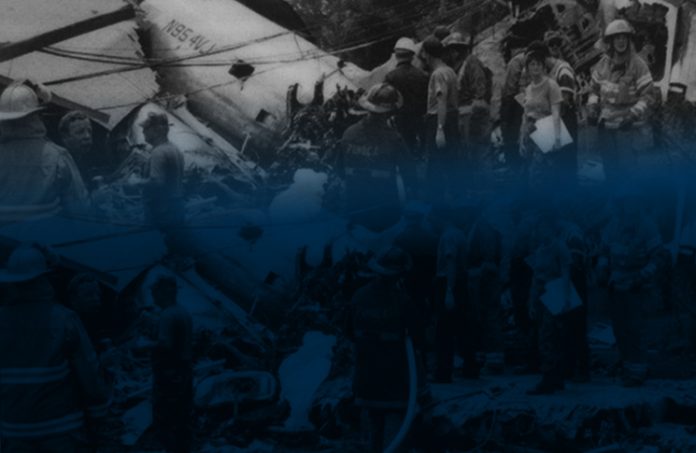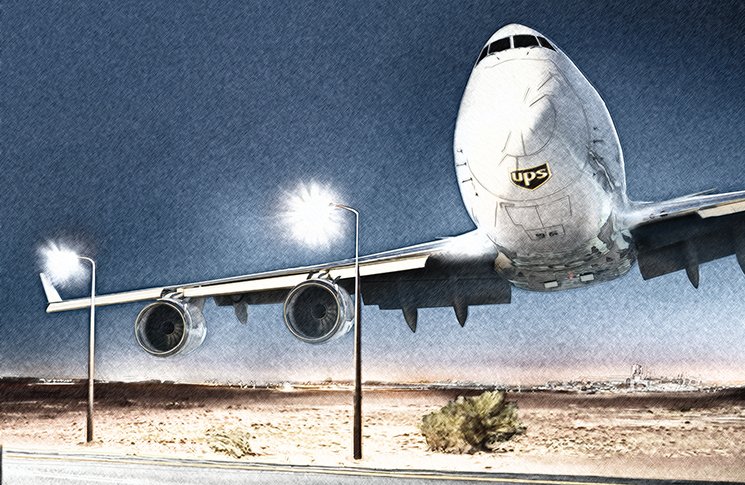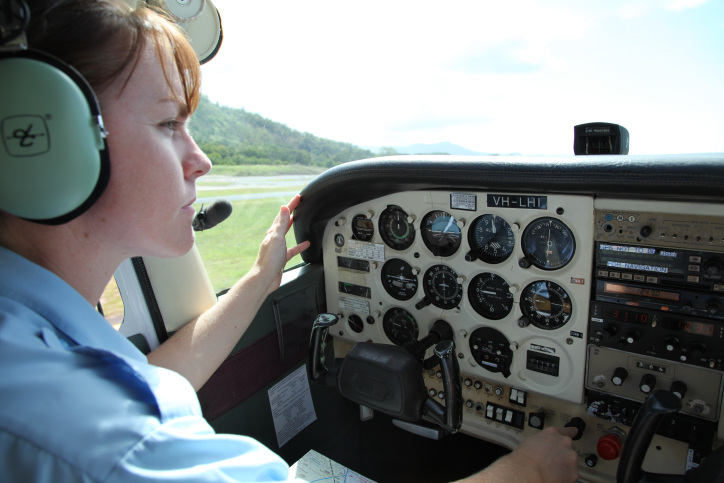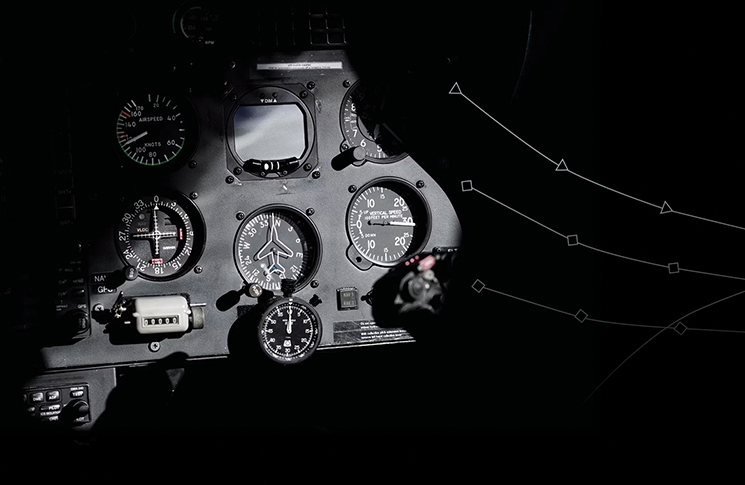One of the first accidents to be dissected by a new theory of causation remains one of that theory’s most telling case studies
By Steve Creedy
Swiss cheese was probably not on anybody’s mind at the US National Transportation Safety Board (NTSB) hearings conducted in the autumn of 1994 into the crash of a McDonnell Douglas DC-9.
Earlier hearings that year, in Charlotte, North Carolina, had heard the pilots of USAir Flight 1016 recount the startling impact of a powerful microburst and the associated windshear.
The DC-9 had flown into the microburst as it tried to conduct a missed approach from runway 18R at Charlotte Douglas International Airport in what turned out to be a fatal confluence of weather and human factors.
The microburst was later determined by a NASA simulation to be 3.5 kms across and capable of producing a rainfall rate of about 250 mm per hour, along with a wind change near the ground of 75 knots and up to 86 knots at 300 feet.
The strongest downward vertical winds below 300 feet were calculated to be 10 to 20 fps.
‘We just dropped,’ Captain Michael Greenlee told the NTSB hearing. ‘I have never had a sensation like that. It was like having a rug pulled out from under you after having such a smooth ride.’
Flight 1016 was on final approach to 18R on 2 July 1994 when heavy weather swept through and an air traffic controller warned of a windshear alert on the airport’s north-east boundary.
Seeing a storm ahead on the DC-9’s radar and flying into heavy rain, Greenlee opted for a go-around to the right rather than fly straight ahead.
It quickly ran into trouble.
Losing speed and unable to gain altitude, Flight 1016 touched down about 800 m from the airport boundary before ploughing through trees and skidding down a nearby road.
The DC-9 broke into 4 major sections, with the rear part of the fuselage coming to rest in a house carport.
All 5 members of the crew survived the crash, despite some serious injuries, but 37 of the 52 passengers were killed.
It marked the start of a bleak period for USAir and the airline would again be plunged into turmoil in early September with the loss of a Boeing 737 at Pittsburgh with 132 people on board.
In determining the probable causes of the Flight 1016 tragedy, the NTSB highlighted several mistakes made by the pilots as well as flaws in the way windshear alerts were handled.
These included the flight crew’s decision to continue an approach into severe convective activity that was conducive to a microburst. They also did not recognise a windshear situation in a timely manner.
Investigators also found the crew did not establish and maintain the proper aircraft attitude and thrust setting necessary to escape the windshear.
However, as is often the case with air accidents, the situation was complicated.
The NTSB’s final report also noted that contributing factors included a lack of real-time adverse weather and windshear hazard information from air traffic control.
A series of events and decisions had lined up like holes in consecutive slices of Swiss cheese, to allow events to proceed to their fatal conclusion.
What became known as the James Reason Swiss cheese model has since been entrenched as a safety metaphor.
In its simplest form, the model supposes accidents are prevented by a series of barriers to issues such as organisational failures, unsafe supervisions, pre-conditions and unsafe acts.
Imagine 4 slices of Swiss cheese in a stack. The holes in the cheese represent weaknesses in the system through which an ‘accident opportunity’ is trying to pass. As long as at least one hole fails to line up, a barrier remains that can prevent an accident.
The NTSB highlighted several mistakes made by the pilots as well as flaws in the way windshear alerts were handled.
Events turn sour when holes on all 4 slices line up to allow the accident opportunity to pass through unhindered.
Add more slices, and this is what happened with Flight 1016 as it flew towards the airport on an instrument landing system (ILS) approach with first officer James Hayes at the controls.
One question considered by investigators was the timing of the pilots’ decision to abort the landing.
The timeframe under discussion is just over 6 minutes. The crew contacted the final radar (approach) controller at 18.36; they contacted the tower controller at 18.38; the go‑around was ordered at 18.41.58; the sound of the crash was recorded at 18.42.35.
The NTSB found the pilots were exposed to at least 3 cues that should have alerted them to the probability of windshear and prompted them to abandon the approach earlier than they did.
These were the convective weather conditions that prompted the crew to decide to conduct the missed approach to the right, subsequent cockpit discussion about the location of the rain and the view that the continuing the ILS approach offered a strong likelihood of encountering a microburst.
A series of events and decisions had lined up to like holes in consecutive slices of Swiss cheese to allow events to proceed to their fatal conclusion.
There was also critical information the crew did not receive because of inadequate procedures and a breakdown in communications in the Charlotte air traffic control tower.
For example, the automated terminal information services (ATIS) heard by the DC-9’s crew as they approached the airport did not indicate rain and thunderstorms were present in the area.
This was upgraded shortly afterwards to reflect the thunderstorms but was not broadcast until 18.43.
Although higher-resolution Doppler weather radar had not been installed at Charlotte in 1994, the existing system had shown conditions were deteriorating with heavy precipitation.
However, the final radar controller advised Flight 1016 at 18.36.59 only that there was ‘some rain just south of the field, might be a little bit comin’ off the north’.
One positive result of the string of events leading up to Flight 1016 was that the US Congress expedited the installation of Doppler radar feeds in air traffic control towers.
Observations by ATC personnel about decreasing visibility for runway 18R in the 4 minutes prior to the accident were also not transmitted to the Flight 1016 crew, nor did they advise of a broadcast from another USAir flight that delayed its departure, due to a ‘storm right on top of the field here’.
When Greenlee requested a pilot report from a Fokker 100 that landed ahead of Flight 1016 on 18R, the local controller relayed the F100 pilot’s comments that it was a ‘smooth ride’.
The crew did receive 2 wind reports from a tower controller and a transmission at 18.41.05 mentioning a windshear alert at the airport’s north-east boundary. But they did not hear a windshear alert to all aircraft broadcast on a different frequency.
Another factor playing into the chain of events was flawed software in the DC-9’s on-board windshear detection system.
The crew said they did not receive any visual or aural warnings from the Honeywell system and there was no indication it had sounded the alarm on the cockpit voice recorder.
Investigations into the Flight 1016 crash would prompt the NTSB to request a US Federal Aviation Administration warning about the Honeywell system after it was found alarms were delayed when the flaps were moving.
Another reason the pilots were unaware of a general windshear alert at the airport was because it was delayed by an unlucky combination of winds.
The airport’s low-level windshear alert system comprised 6 anemometers monitored by a computer that needed windshear warnings from 4 of the sensors to issue a general alert.
The NTSB hearings were told that at the time Flight 1016 was on final approach, winds at 3 anemometers were strong enough to trigger the warning but those at a fourth had dropped just below the threshold, preventing the system from issuing the general alert.
A change in any of these factors could have prompted the pilots to make a different decision but they were apparently unaware they were entering the edge of the microburst system, as Greenlee commanded Haye to execute the missed approach to the right instead of flying ahead.
As the aeroplane banked, Haye raised the nose and advanced the throttles but the thrust was set below the maximum go-around limit.
To complicate matters, Greenlee was heard on the cockpit voice recorder saying, ‘Down, push it down’ – the opposite of what pilots are trained to do in windshear.
Both Greenlee and Haye said they did not recall the statement being made but the flight data recorder showed the pitch changed from 15 degrees nose-up to 5 degrees nose-down.
The NTSB theorised the increase in thrust, the forces due to the aircraft banking and pitching and the sudden loss of visibility, may have caused a form of spatial disorientation that led Greenlee to believe the aircraft was climbing at an excessively high rate.
One positive result of the string of events leading up to Flight 1016 was that the US Congress expedited the installation of Doppler radar feeds in air traffic control towers.
Flight simulations suggested the aircraft could have overcome the windshear if the proper pitch of 15 degrees nose-up had been maintained, the thrust had been set to the standard go-around limit and the landing gear had been retracted on schedule.
‘The combination of the crew’s failure to use maximum go-around thrust, the reduction of pitch attitude at a critical phase of flight resulted in the airplane descending to the ground,’ the NTSB concluded.
CASA Flight Simulation Team Leader John Frearson is a veteran pilot who began his career with Trans Australia Airlines (TAA) and helped Korean Air improve its operations after a string of high-profile crashes in the 1990s.
He is experienced on DC-9s and says Flight 1016 was a classic example of the Swiss cheese model in action.
Frearson notes the circumstances were almost mirrored more than 6 years later during a 2001 Qantas incident in Brisbane, this time without the fatal consequences. In that case, a 737 encountered a microburst at 0729 EST while conducting a go‑around from runway 19 during an intense thunderstorm.
In the case of the Charlotte crash, Frearson says the string of events stretched all the way back to the TV weather forecast the previous night, through to dispatch, the landing briefing, approach control, the ATIS and more.
‘There are probably 16 slices of Swiss cheese you can identify,’ he says. ‘But as you get closer and closer, it’s the pilots who hold that very last slice in their hands.
‘It’s that concept of the last slice – who owns it and how are they prepared for it?
‘Students of Reason’s Swiss cheese theory will find much to ponder in this accident and pilots need to consider what happens when they are in possession of that last piece of Swiss cheese.
‘At some point prior to the decision to execute a go-around – it could have been as late as 15 seconds – the USAir pilots had in their hands enough information to avoid the accident.’
After conducting an ‘awful lot of flight data analysis’ of go-arounds, Frearson says they were often poorly flown.
He believes simulator training is the best way to prepare airline pilots for events such as windshear but it needed to be done well so that it instilled a ‘muscle-memory’ response.
‘If you do it often enough, it will be done properly but you can’t just say, “Now we’ll do windshear training” and that’s it,’ he says.
‘The truth is the decision to recognise the need for, call out and execute a properly executed go-around, is the passenger’s best friend, the pilot’s best friend and the best invention in aviation.’






This is a prime example of why Reason’s model is no longer effective in a pro-active flight safety system. It is too linear and tells us nothing in a complex social-technocal system such as aviation. It only follows a path backwards from the end event, i.e hindsight. We cannot predict the future let alone go into the past and predict another outcome. A more modern and effective method is to be found in resilience engineering. You have an expert in these matters in Australia. Prof Sydney Dekker at Griffith University. I suggest you contact him, get the “new view” on safety and publish something about that. If not, we’ll keep repeating mistakes of the past and not be pro-active. Look closely at the Bow-tie method and you see an expanded swiss cheese model that really doesn’t provide the results we think it provides. It gives us a warm fuzzy feeling and complex with CAA requirements but is of limited practical use.
Anyway, thanks for posting this as I will use it as an example of why swiss cheese doesn’t work.
regards Stephen